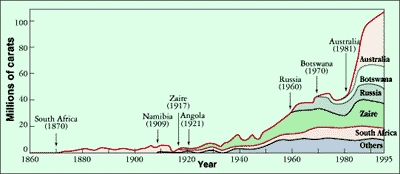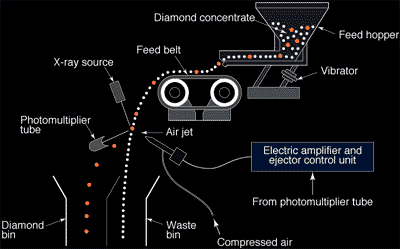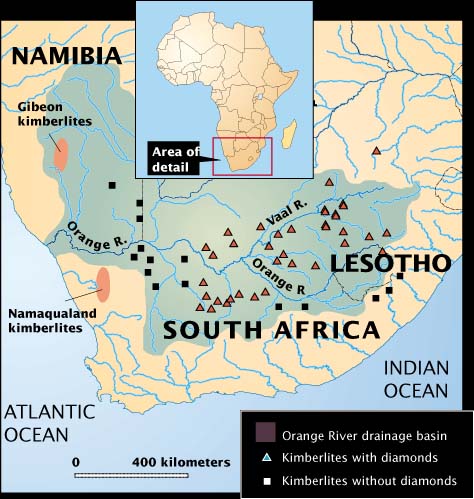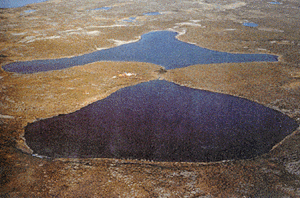Diamond Deposits
Diamond Deposits
Australian diamonds
World diamond distribution
Where diamonds come from
How diamonds move to the earth's surface
Origins of the carbon
Where to look for diamonds
Two types of diamond deposits
The age of kimberlite and diamonds
Diamond crystals
Xenoliths - hitchikers from the centre of the earth
Indicator minerals
Mining
New sources of diamonds
Alluvial mining
Processing diamond ore
Sorting and grading
Marine deposits
Southern African diamonds
South American diamonds
Canadian diamonds
India diamonds
Russia diamonds

Australia - Diamonds
While minor diamond discoveries were made among alluvial gold in New South Wales starting in 1851, a discovery in 1979 on the Kimberley Plateau of Western Australia enabled the country to be the world's most prolific diamond producer. Based on ancient bedrock, diamond exploration began in 1972, with a kimberlite pipe discovery coming in 1976 in the Ellendale area. In 1979, a large lamproite pipe was found and named the Argyle mine; by 1992 over 200 million carats had been mined there. Only 5% of the production is gem quality. A unique feature of the Argyle mine, though, is a small but consistent supply of valuable pink to red or purple diamonds.

The Argyle mine on the Kimberley plateau of Western Australia.
Australian Production
Total: 428 million carats Annual: 35-40 million carats
World Distribution of Diamonds

Source of Diamonds
Experiments and the high density of diamonds tell us that they crystallize at very high pressures. In nature this means that diamonds are created by geologic processes at great depth within Earth, generally more than 150 kilometers down, in a region beneath the crust known as the mantle. Other processes, bring diamonds to where people can find them.
The upper mantle is slightly plastic, which allows it to circulate slowly in a creeping, convective flow that helps drive the surface motion of Earth known as "plate tectonics." The cross section shown here provides a closer look at Earth's crust and underlying mantle. The crust can be divided into ocean basins, underlain by a thin layer of dense, basaltic rock, and continents, formed of a much thicker but less-dense layer of granitic rocks. Just below the crust is the portion of the mantle called the lithosphere, which is rigid and acts like rock. Below this is the asthenosphere, a more plastic, flowing region that enables the overlying crustal plates to move in what is known as plate tectonics.

The plot of pressure and temperature shows the conditions at which either diamond or graphite exist. The general conditions present in the Earth are described by curved lines called geotherms. Note that there are two geotherms: Because the continental crust is old and thick, conditions are somewhat colder in and beneath it than beneath the much younger ocean basins. Diamonds can form at depths as shallow as 150 kilometers beneath the continental crust, while beneath oceans they need depths of at least 200 kilometers, as shown by the diamond boundary on the cross-section.
Diamond is amazingly dense. At 3.51 grams per cubic centimeter, it is vastly more dense than graphite -- the more common form of the light element carbon -- at 2.20 grams per cubic centimeter. This comparison offers an important clue to diamond's origin: The fact that diamond is "squeezed" much denser than graphite, which forms near Earth's surface, implies formation at high pressure. As shown on the graph, this concept was corroborated by experimental synthesis of diamond at high pressure and temperature.

This simplified diagram shows the conditions of pressure and temperature where diamond and graphite will be the stable forms of carbon. The points show the conditions at which diamonds were first grown by the companies ASEA and General Electric in the early 1950s. Temperatures are in Kelvin; subtract 273 to convert to degrees Celsius. This magnitude of high pressure is difficult to comprehend. For example, the pressure of 55,000 atmospheres necessary to make a diamond at 1400 degreesC (orange hot) would require:
The Eiffel Tower (7000 metric tons) resting on a 5 inch plate;
10 Anighito meteorites (10 X 20 metric tons) resting on a 5 cent piece.
How Diamonds get to the Surface
Diamonds ascend to Earth's surface in rare molten rock, or magma, that originates at great depths. Carrying diamonds and other samples from Earth's mantle, this magma rises and erupts in small but violent volcanoes. Just beneath such volcanoes is a carrot-shaped "pipe" filled with volcanic rock, mantle fragments, and some embedded diamonds. The rock is called kimberlite after the city of Kimberley, South Africa, where the pipes were first discovered in the 1870s. Another rock that provides diamonds is lamproite.
The volcano that carries diamond to the surface emanates from deep cracks and fissures called dikes. It develops its carrot shape near the surface, when gases separate from the magma, perhaps accompanied by the boiling of ground water, and a violent supersonic eruption follows. The volcanic cone formed above the kimberlite pipe is very small in comparison with volcanoes like Mount St. Helens, but the magma originates at depths at least 3 times as great. These deep roots enable kimberlite to tap the source of diamonds.
Magmas are the elevators that bring diamonds to Earth's surface.
Origins of Carbon for Diamonds
Most diamonds consist of primeval carbon from Earth's mantle, but those from eclogites probably contain carbon recycled from the ocean crust by plate tectonics -- the carbon of microorganisms. How do we know? Carbon atoms occur in three different masses, or isotopes. Unlike high-temperature processes in deep Earth, low- temperature, biological processes, such as photosynthesis, are sensitive to the differences in mass, and actively sort different carbon isotopes. Thus, the ratios of carbon isotopes in organic materials -- plants, animals, and shells -- vary, and also differ from those in the carbon dioxide of the atmosphere and the oceans. Geochemists "read" the carbon isotopes in samples to interpret nature's record.Virtually all carbon atoms, the ones in a diamond or a tree or you, came from the stars. Particularly at Earth's surface the proportions of 12C and 13C (the carbon isotopes of mass 12 and 13) get redistributed. Expressed as simple numbers in 13C notation -- in which larger numbers mean more 13C -- organic carbon has large negative values, average Earth has a mildly negative value, and the carbon in shells is near zero.

The narrow range of 13C values for harzburgitic diamonds in the histogram on the top resembles the range of average Earth, indicating that the mantle is the likely carbon source. The large range for eclogites suggests mixing of organic carbon (the strongly negative numbers), mantle carbon (mildly negative numbers), and shell-like carbon (values near zero).
These data support recycling of once-living carbon from Earth's surface deep into the mantle to form diamond.

When ocean floor slides into the mantle, the basaltic rock becomes eclogite, and organic carbon in sediments may become diamond.
Where to look for diamonds
The search for diamonds has determined that most are derived from kimberlite pipes in the oldest, nuclear portions of the continents, where the basement rocks are older than 1.5 billion years.
The oldest parts of continents are called cratons, and can be divided into two terranes: Archean-age archons, which are older than 2,500 million years, and Proterozoic-age protons, which are 1,600 -- 2,500 million years old. The distribution of these terranes is shown on the map.
Kimberlite pipes occur in many parts of the continental crust, but most diamond-rich ones are found in archons. This fact suggests that most diamonds were formed and stored deep below the cratons, in the area shown in the lower figure, and were later transported to the surface by kimberlite and lamproite magmas that extracted them and other samples from the mantle.

Kimberlite and Lamprolite
The complex volcanic magmas that solidify into kimberlite and lamproite are not the source of diamonds, only the elevators that bring them with other minerals and mantle rocks to Earth's surface. Although rising from much greater depths than other magmas,
these pipes and volcanic cones are relatively small and rare, but they erupt in extraordinary supersonic explosions.
Kimberlite and lamproite are similar mixtures of rock material. Their important constituents include fragments of rock from Earth's mantle, large crystals, and the crystallized magma that glues the mixture together. The magmas are very rich in magnesium and volatile compounds such as water and carbon dioxide. As the volatiles dissolved in the magma change to gas near Earth's surface, explosive eruptions create the characteristic carrot- or bowl-shaped pipes.

Kimberlite magma rises through Earth's crust in networks of cracks or dikes. The pipes only form near Earth's surface. This cross-section of a kimberlite pipe shows the carrot-shaped profile produced by explosive eruption. The root zone starts in fissures, where gases are released from the rising magma and drive the eruption; they blow out the fragment-laden kimberlite to form the volcano's tuff ring and fill the pipe.
Depth measurements show the level of erosion for various kimberlite pipes in South Africa. Adapted from Hawthorne (1975).

These drawings illustrate the formation and filling of the typical champagne-glass shape of a lamproite pipe. The initial stage of the eruption, powered by gases either from the lamproite magma or from boiling ground water, corrodes the hosting rock to form the champagne-glass shape (top). The eruption then produces particles of ash, lapilli, and pumice that partially fill the crater and form a tuff ring (middle). Finally, the crater fills with a lava pond from the degassed lamproite magma (bottom). Adapted from a sketch by Barbara Scott-Smith
Age of Diamonds and Kimberlites
Kimberlites are generally much younger than the diamonds they bring to Earth's surface. Kimberlites and lamproites have been dated between 50 and 1,600 million years old. Diamonds associated with harzburgites are about 3.3 billion years old -- more than two thirds the age of Earth itself, and those from eclogites generally range from 3 billion to less than 1 billion years old. These age differences help clarify a picture of diamonds having crystallized and been stored beneath the ancient continental cratons and only later being lifted to Earth's surface by kimberlites.Since inclusion minerals crystallized simultaneously with their diamond host, the age of the inclusions gives the age of the diamond. The ancient age of peridotite diamonds suggests that the formation of ancient Archean continental cores (archons) included diamond crystallization in the underlying mantle lithosphere. A relatively cool, rigid, deep keel beneath these continental nuclei provided a stable environment in which diamonds crystallized and were stored. Subsequently, oceanic crust diving into the mantle was metamorphosed into eclogite and pasted onto this keel. Much later passage of kimberlite magmas through the keel dislodged diamonds from both peridotite and eclogite and sent them to Earth's surface.

This cross-section of continental crust shows the 200-km-thick cool keel (part of the mantle lithosphere) that provided a stable environment for diamond crystallization and preservation.
Kimberlites centered over the keel are likely to yield harzburgite-hosted diamonds from the storage zone (marked with diamonds).
Kimberlites near the edge of the keel are more likely to contain eclogite-hosted diamonds, while those off the keel are likely to be barren of diamonds.
The Two Types of Diamond Deposits
Geologic processes create two basic types of diamond deposits, referred to as primary and secondary sources. Primary sources are the kimberlite and lamproite pipes that raise diamonds from Earth's mantle, where they originate. Secondary sources, created by erosion, include such deposits as surface scatterings around a pipe, concentrations in river channels, and fluxes from rivers moved by wave action along ocean coasts, past and present. Mining of these deposits depends upon sufficient concentration and quality of diamonds.
The diagram here shows the trail of diamonds left by geological processes.
The primary deposits, or diamond pipes, are the vertical portion. The flared top of the pipes can yield substantial quantities of diamonds, but following the narrowing pipe downward eventually becomes unprofitable. Note how erosion of the landscape moves surface minerals -- including the diamonds -- from the pipes down hills, streams, and rivers to their ultimate destination, the ocean.
Because diamonds are dense they concentrate at the bottom of active zones of moving sand and gravel. These secondary deposits are eluvial Ð above a pipe, colluvial -- adjacent to a pipe, alluvial Ð stream and river transported, and marine -- along beaches that can wind up onshore or offshore with changing sea level. Secondary deposits may be found far from active means of transport, in the fossilized channels of now-vanished rivers or under fossil beaches.
Diamond Crystals

The diamond octahedron has the shape that we describe as a diamond. While it is the most common shape for a diamond crystal, cubes, dodecahedra, and combinations of these three shapes are common. All are highly symmetrical, with equal dimensions in three perpendicular directions, and all are manifestations of the cubic crystal system to which the mineral diamond belongs.





Exceptions are the flat form called a macle, which is a twin, or composite crystal, as if mirrored across the middle, and etched crystals, with rounded surfaces and, sometimes, elongated shapes. The shapes of diamond crystals can be very intriguing.

These triangles result from subtle changes in height on a diamond's octahedron face and are called trigons. The trigons shown here are indentations, probably produced by natural etching of the crystal. The image was created with Nomarski differential interference contrast microscopy and is 0.29 mm across.
Xenoliths - hitchikers from the center of the earth
Kimberlite magmas carry foreign rocks -- xenoliths -- from Earth's mantle to the surface. Xenoliths are geologists' only samples from the deep Earth, and carry information about diamond growth conditions.The 2 most common types of xenoliths are peridotites and eclogites.
Peridotite is the main constituent of the mantle beneath the crust and consists primarily of olivine -- the gem variety is peridot.
Eclogite, consisting primarily of garnet and a green pyroxene, is formed by plate tectonics when basalt of the ocean crust founders into the mantle. Certain kinds of xenoliths contain diamonds.

These diagrams show the compositions of mantle xenoliths.
Lherzolite is a variety of peridotite thought to form most of the upper mantle.

Harzburgite is another kind of peridotite with less clinopyroxene.
Garnet harzburgites contain red garnet and, occasionally, diamonds.

Eclogite, a very different rock, consists of garnet and sodium-rich pyroxene; some also contains diamonds.
Diamond inclusions
Diamonds with inclusions are like little space capsules from the mantle: pristine mineral samples are protected by the diamond's indomitable embrace and transported to the surface by a volcanic rocket.
Inclusions capture a picture of the rock and environment in which diamonds grow and indicate that garnet harzburgite (a type of peridotite) and eclogite are the most common rocks in which diamonds have grown.
A single mineral inclusion rarely defines a specific rock, but two or more minerals may enable interpretation of rock associations and origin. Some inclusion minerals are virtually unique to diamond sources and are thus sought in the exploration for diamonds.

A purple pyrope garnet, an indicator of garnet harzburgite, in a brownish diamond octahedron from the Udachnaya pipe, Sakha Republic, Russia (about 0.8 mm across).
Indicator Minerals for Diamonds

Certain minerals are present in the rocks from the upper mantle that occur with diamonds in kimberlite and lamproite pipes, as seen in nearby cases of xenoliths and diamond inclusions. Some of these minerals, being resistant to weathering and denser than quartz sand, concentrate in channel bottoms. Because they occur in far greater abundance than diamond, exploration geologists look for these "indicators" among the gravel of regions they suspect may host diamond-bearing pipes.
Indicator minerals for diamond include, in order of decreasing significance: garnet, chromite, ilmenite, clinopyroxene, olivine, and zircon. But the order of persistence in streams is zircon, ilmenite, chromite, garnet, chromian diopside, and olivine. Diamond itself is obviously a most important indicator.
Most indicator minerals have a distinctive color. Seen here are red pyrope garnets, green chromian clinopyroxene, black ilmenite and chromite, and yellowish-green olivine.
Diamond Mining
Mining of a diamond-bearing pipe starts with the excavation of a pit into the pipe. In this process, called "open-pit" or "open-cast" mining, the initially loose and eventually hard ore material is removed with large hydraulic shovels and ore trucks. Hard rock is drilled and blasted with explosives so the broken material can be removed. When deep, rich ore warrants it, the mining goes underground with vertical shafts descending to horizontal drifts, or passageways that enter the pipe.A cross section of the underground workings at the Dutoitspan mine, Kimberley, South Africa. Adapted from De Beers
In bedrock adjacent to the pipe, shafts are sunk and drifts are tunneled into the pipe. The highly mechanized and efficient method known as block caving is shown in the adjacent model. Concrete-lined tunnels are excavated under a large vertical section, perhaps 140 to 180 meters (400 to 600 feet) of kimberlite.
Along the tunnels are draw points, or openings in the concrete casing where kimberlite is drilled and blasted to cave in a section above the tunnel. Broken kimberlite falls through the draw points and is scraped out of the tunnel with a drag or scraper bucket attached to a cable and winch, working much like a clothes line on a pulley.
The kimberlite above the tunnels falls under its own weight and leads to a slow, continuous caving of ground that is removed through the draw points. The scraped kimberlite rubble is loaded into cars on a lower level and moved to a crusher underground. The crushed ore is then conveyed to skips that carry the ore up the vertical shaft for processing.
New Sources of Diamonds
In the last 20 years scientists have discovered new sources of diamond. Continental collisions -- a result of plate tectonics -- can subject slices of a crust to immense burial and uplift. In Kazakhstan, for example, diamonds formed in buried crust that returned to Earth's surface. Meteor impacts produce immense pressures, and diamonds can be formed and sprayed among the impact debris. Meteorites also experience impacts themselves and can contain diamonds. And the most ancient meteorite material contains star dust, the remnants of the death of stars. Some of this star dust is extremely tiny bits of diamond, just big enough to be crystals and older than the solar system itself.Very small "microdiamonds," averaging only 12 micrometers across, were discovered during diamond exploration in a region called the Kokchetav Massif, in northern Kazakhstan, in large slices of metamorphic rock that must have been pushed at least 120 kilometers deep into Earth and returned.
Discovery of this process, termed ultrahigh pressure (UHP) metamorphism, has revolutionized ideas about and interest in what can happen to Earth's crust. Recently scientists have found traces of diamond around meteor impacts.

Cartoon of the formation of a UHP terrane that can yield diamonds. At top, the down-going subducted ocean crust (green) has a thin covering of sediment (gray) that is sheared off and driven upward (inset), apparently caused by the continental collision (middle) that squeezes the diamond-bearing metamorphic rocks back into the crust (bottom).
At the 35-million-year-old Popigai crater in Siberia, graphite transformed into microdiamond aggregates up to 1 centimeter across. It is now suspected that diamonds form in most major impacts, becoming a new indicator of ancient cosmic collisions. In 1987, microscopically small fragments of diamond, called "nanodiamonds," were recovered from meteorites that predate the solar system. New studies indicate that they formed more than 5 billion years ago in flashes of radiation from dying red-giant stars into surrounding clouds of methane-rich gas. The process is essentially the same as the new process for growing synthetic diamond called CVD -- chemical vapor deposition.
Alluvial Mining

Most of the diamond deposits first discovered were alluvial -- concentrations in streambed or riverbed sand and gravel. They are still actively exploited in many ways, from the most primitive to the highly sophisticated. The goal is relatively simple: to find a location where moving water has deposited diamonds in the bottom of a channel, possibly in a pocket or cleft. Because rivers meander and drainage can change, fossilizing a once active river, the search for alluvial diamonds requires some geological knowledge and a lot of luck. The process involves removing the overlying barren ground, digging up the bearing ground, extracting the diamonds, and, nowadays, restoring the landscape when finished.
In the most basic, individual operations, such as in Sierra Leone or Angola, the technology involves shovel and pan, with some hand sloshing to gravitate diamond to the bottom of the pan; the eye is the ultimate sorting device. Mom-and-pop operations in South Africa involve a small claim and utilize limited technology -- shovels, buckets, jury-rigged cranes powered by small vehicles, and the like -- to load a small washing pan. The concentrate is then sieved into several size ranges, and each fraction is dumped onto a picking table, where someone checks by eye for diamonds. In the bigger operations, as shown in the model, large earth-moving equipment transports the alluvium, and the processing approaches that of the primary mines -- coarse sieving, then rotary sieving in a trommel, before loading into a large washing pan. Final processing includes concentrate sieving, a picking table, and usually a grease table. Of course, no crushing is required, as nature has already released the diamonds from the pipe rock.
The Processing of Diamond-Bearing Ore
Once a mining operation yields ore, the diamonds must be sorted from the other materials. This process relies primarily on diamond's high density. An old but effective method is to use a washing pan, which forces heavy minerals like diamond to the bottom and waste to the top. Cones and cyclones use swirling heavy fluids mixed with crushed ore to achieve density separations. With 99 percent of the waste in the ore removed, further separations may use either a grease table or an x-ray separator. Final separation and sorting is done by eye.Crushed ore is mixed with a muddy water suspension, called puddle, and all is stirred by angled rotating blades in the circular washing pan. Heavier minerals settle to the bottom and are pushed toward an exit point, while lighter waste rises to the top and overflows as a separate stream of material.

A working grease table at Longlands, Cape Province, South Africa. The surface of diamond is highly unusual in that it resists being wetted by water but sticks readily to grease. Here, wet gravel washes across 3 inclined surfaces covered with beeswax and paraffin. Diamonds stick to the grease while wetted waste minerals flow past. The operator routinely scrapes the material that adheres to the table into a grease pot, using a trowel. The grease in the pot is melted and the diamonds are removed in a strainer. More automated systems use a rotating grease belt and scraper.

Cones (left) and cyclones (right) use heavy-media separation. Diamond-bearing concentrate is mixed with a fluid near the density of diamond. Separation occurs in cones and cyclones by swirling the mixture at low and high velocities respectively.In the cone, rotational mixing permits lighter minerals to float to the top and run out as overflow, while diamonds and dense minerals sink to the bottom and are sucked out with a compressed air siphon.
In the cyclone, fast rotation of the suspension drives heavy minerals to the conical wall, where they sink to the bottom and are extracted, while float waste minerals are sucked from the center of the vortex. Cyclones are about 99.999% efficient at concentrating diamonds and similarly dense minerals from the original ore. Adapted from Bruton (1978)

The x-ray separator system acts on a thin stream of particles from the concentrate accelerated off a moving belt into the air, where they encounter an intense beam of x-rays. Any diamond fluoresces in the x-rays, activating a photomultiplier that triggers a jet of air, deflecting the diamonds (blue) into a collector bin. Adapted from Bruton (1978)
Sorting and Grading of Diamonds
There are two aspects of moving diamonds from mine to dealer. The first is the fairly straightforward but important task of separating diamonds into gem-quality, near gem-quality, and industrial-grade diamonds. The second is the more intriguing aspect: the primary diamond marketing, which has been and still is largely controlled by De Beers Consolidated Mines, Ltd. through its majority control of the Central Selling Organization (CSO). The CSO sells a large percentage of mine production to diamond dealers; independent mines sell by closed bids and through private transactions.
Sorting small diamonds in a Botswanan operation.

Sorting occurs at every level of the market, from the mine to the jeweler. At the mine, the sorting depends on the sophistication of the operation and the size of production, but it is always based on grouping stones of like type. Diamonds are grouped into "sizes" -- more than one carat; "smalls" -- between 1 carat and 1/10th carat; and "sand," -- less than 1/10th carat, with some leeway for market pressures.
Diamonds larger than about 15 carats are handled individually. Shape groups comprise "stones," "shapes," "cleavages," "macles," and "flats," describing characteristics familiar to the market. The ultimate purpose of sorting is to estimate an asking price for the rough diamonds.
After great swings in diamond prices, the Diamond Trading Corporation (DTC) was set up by De Beers in 1934 to handle the actual sales of diamonds. The DTC and the Diamond Producers' Association (the mine operators) form the nucleus of the Central Selling Organization. The CSO stabilizes prices in hard times and raises them in accord with inflation and demand during good times. It needs considerable wealth and stockpiles of diamonds to maintain this position, but this "single channel marketing" system has been an effective cartel. In the United States cartels are illegal, so De Beers cannot operate here. However, the company's interests are represented by a public relations office, the Diamond Information Center, and indirectly by the diamond dealers and jewelers who sell the gems.
Marine Diamond Deposits

Marine deposits are a variation on alluvial deposits. They result from the wave action of the ocean, which has concentrated diamonds at the base of the surf zone. Waves arriving at an angle to the coast tend to push the diamonds along the coast, causing the diamonds to stream out from where rivers deposited them at the coastline. Moreover, changes in climate have led to great variations in sea level -- hence movement of diamond concentrations to both old beaches well up on land and others now more than 100 meters below sea level.
There are 3 types of marine mining operations. In one, sand is moved from 10 meters below sea level to as far inland as the sea may have risen, in order to reveal the concentrations on the bedrock. In another, divers and boats work in the surf zone to perhaps 20 meters of water and use suction pipes to remove gravel and diamonds from the ocean floor. In the third, deep-sea marine vessels use remote underwater tractors or large underwater excavators to remove overlying sediments and extract the diamond-bearing sand and gravel. Processing is done on land in the first 2 cases and shipboard on the large mining vessels.
Wave refraction maps like this one for concession 2(b) along the South African coast are used to assist in locating concentrations of diamonds. The map shows where the wave force is maximized, and thus where diamonds will have been concentrated by wave action. Wave power is transformed into the visible spectrum, so that blue represents weak and red strong power.
Diamonds in South Africa

South America Diamonds

Canada - Diamonds

With much of Canada underlain by ancient bedrock, the existence of diamond-bearing kimberlite has been considered very likely, particularly with tantalizing diamonds found in Wisconsin in deposits swept down by glaciers from up north. Now the country is home to the latest major diamond discovery.
Intermittent exploration for kimberlites by major companies was unsuccessful through the 1980s. But Chuck Fipke, head of Dia Met Minerals, persevered and in April 1990 located a kimberlite under Point Lake. Eventually, his company, with partner BHP Minerals, found more than 100 kimberlites on their claims; 42 contain diamonds. Five small pipes, to be operated as if they were one mine, are scheduled to start production in the second half of 1998.
The first kimberlite pipe discovered in the Northwest Territories is under Point Lake. The top of the kimberlite lies about 50 m below the surface of the lake, which is 600 m wide.
Diamonds in India

Diamonds in Russia


